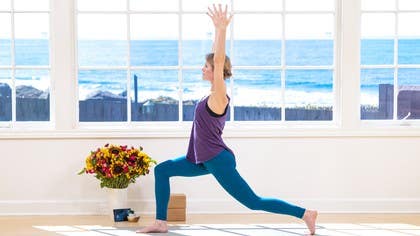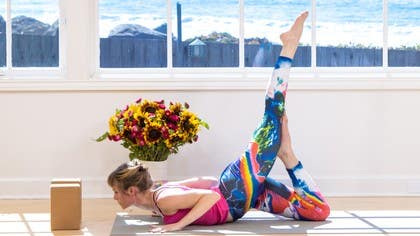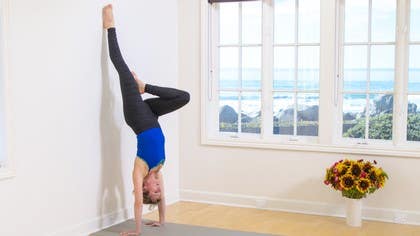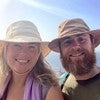Description
About This Video
Transcript
Read Full Transcript
Hi, thanks for being here. In this sequence we will be working with this idea of there being space available within the body and our work will be to locate the space that's always available. I'm glad you're here. We'll begin in table pose, hands and knees, and like really take your time to feel your way into a shape that feels stable in this moment regardless of how many times you've practiced this shape and how many variations of alignment instructions you've received. Feel your way into it this time as if it were the first. And once you're in, take a gander at stability, the contact that the hands are making with Earth, the distance between the hands, the contact that the knees and the feet are making with Earth and distances there and just be present to that. We'll take in a full breath here into the back of the body, into the space available in the back of the body. And as you exhale we'll start to move the hips toward the heels and the forehead toward the floor bhaktasana devotional. We'll move the elbows just a little bit closer together, the hands just a little bit closer together, and we'll press the hands into the floor. And now we'll flow here between a couple of shapes at the pace of your own breath. So as you inhale, press the elbows, forearms and hands into the floor as you lift your booty and roll onto the top of the head, lifting the head last. And as you exhale, again move hips toward heels, forehead toward floor bhaktasana devotional. And we'll continue this way at the pace of your own breath, lifting the booty, rolling to the top of the head, lifting the head, feeling the alignment, the elegance of the spine and exhaling back to bhaktasana devotional. Give yourself full permission to feel here, to notice. There's no right or way to do this than how you are doing it right now. How about one more, just like that, breathing in, lifting booty, rolling to the top of the head, lifting the head, lengthening into the fullness of the back of the body. And this time as you exhale and lower the hips toward the heels and the forehead toward the floor, we'll stay here, we'll linger here and we'll do a little bit of investigating. Let the hips be heavy and attentive to gravity. And we'll start to walk the fingertips forward toward the top of the mat. As your sacrum is heavy, as the tailbone is heavy, you might lift through the elbows, through the armpits and then soften into the armpits, soften into the pillows of your armpits. Lower the elbows down in time, scooch the elbows and hands a bit closer together and place palm against palm. On an inhalation, start to lift the hands away from the floor so that your fingers start to point straight up. And you might sort of inchworm the elbows a little bit closer to the top of the mat before softening, sagging into the heart, sagging into the armpits. And what do you feel? Now from here you might lift the heels of the hands away from each other and sort of press the tips of the fingers together. Notice what you feel. Notice the space across the back of the shoulders, down the length of the spine. Relax the effort in the hands. On an exhalation, we'll release the hands back down to the earth. Slowly from here, let's roll up to a C, to Vajrasana. And we'll be here for a couple of breaths, and for most of us it makes sense to use something under the bum. I like to use a block between the feet, but you could add or subtract from there. Sometimes it's nice to also add a blanket on top of the block. And here we're really going to get into the space from the top of the shoulder to the lobe of your ear. And we'll do that first by settling in, letting the sitting bones be heavy, letting the tailbone be heavy. And on an inhalation, sweeping arms, and fingers toward the sky. And on an exhalation, bending at the elbows. Let's do that a couple of times, breathing in, reaching up, noticing the length of the front of the body. And as you breathe out, bending at the elbows, noticing the space across the back of the body. And how about two more times, just like that. You're doing it right, so notice what you feel. And this time as you exhale into this sort of cactus arm, goal post arm shape, soften in, settle in, let your hands get a little soft, let your elbows get a little bit soft, let the armpits get even more pillowy, but don't use them as pillows, because that might stink. And pause. I'll speak for myself, I guess. And from here, we're going to just do a tiny little flossing in the neck. And so what you might do is start to just press the right side of the jaw forward. And there's no way to mess this up. We're just pressing the right side of the jaw forward, softening the left side of the jaw. And you might even stick your lower chin out. Soft in the shoulders. And in time, come back to center. Notice what you feel. And we'll just slide the left side of the chin forward, just sort of noticing the space from the top of the shoulder to the left ear low. Let the right side be soft. And if you can, if it's right there, start to trace the path from the top of the shoulder to the jaw, and from the jaw to the earlobe. And we'll breathe in and come back to center.
One more inhale, reaching arms, hands, and fingers to the sky. And exhale, release. And then notice, like really and truly, just take a moment to notice the effect. And in time, we'll lift the bum. We'll move our block. And if you like working with blocks in your low lunges or your high lunges, you might bring them to the top of the mat and we'll create sort of either a regular table or an elevated arm table. And again, locate stability for you in this moment. Let's extend the right leg back. Give it a good shake. We call this the Spanx Shake. We, I call it the Spanx Shake. Like anything that Spanx would hold together, let jiggle. Spanx are a girdle. Press the ball of the right foot into the floor. Shine out through the right heel. Feel the length of the back of the body. Notice all the space that's available from the center of the heel to the crown of the head. And on an exhalation, we'll step the left foot forward into kind of a zippy little lunge. Breathe into the fullness of the back of the body. And on an exhalation, we'll lower the right knee down to the earth. And let's for now keep the right toes tucked under. On an inhalation, we'll rock the hips back, moving the left leg towards straight. Let the forehead be heavy in the spine round. And exhale back to your low lunge, gazing forward and up. And we'll move like this at the pace of your breath, feeling your way into it. Feeling your way around it. And if your body suggests experiments to run, then follow those urges. Follow those whims. Our practice is a great experiment. We're trying things out and seeing what happens, seeing what works. And so I think it's useful from time to time to keep returning to the purpose of your own practice. Why am I doing this? And is what I'm doing working? And so the next time that you're inhaling and rocking back, we'll pause here, let the forehead be heavy, let the shoulders be soft. And we'll just linger here for a moment, just long enough to sort of trace the path from the left heel to the back of the left knee to the left sitting bone. Inhale, lift the heart, lengthen the spine and exhale back to the lunge. Place the hands where they're stable and meander back to table. Again, reclaiming, re-finding stability every time that you make your way into the shape. And in time we'll inhale and extend the left leg, give it a good spank, jiggle. Is my butt jiggling? I don't even care. Press the ball of that foot into the floor, press out through the heel. And on an exhalation we'll step the right foot forward. Breathe into the length of the body, this shimmering length of your body from the center of the heel to the top of the head. Like, ah, there's all this space happening. You don't have to do anything. And on an exhalation, lower the left knee down to the earth and we'll work with the breath here. Inhaling, rocking back, forehead heavy, skull soft, and exhale back to the low lunge. Moving at the pace of your own breath. Attending to the places that feel easy and attending to the places that feel hard or challenging, like being there completely. This time on the inhalation we'll pause with the hips rocked back, sort of softening into the base of the skull, softening into that right hip. Noticing the distance from the right heel to the back of the knee, from the back of the knee to the right sitting bone. And on an inhalation, lift the heart, lengthen the spine, exhale back to the lunge. Stabilize the hands, move back to table. For now, move your blocks out of the way but keep them close. And we'll place the hands wide, tuck the toes on an exhalation, move the hips toward the heels, lifting into downward facing dog, Adho Mukashvanasana. And feel your way around in here, sort of like be present to the space within your body and be present to the relationship between your body and this particular shape. And the relationship between your body in this shape and the environment, the earth beneath you, how are you making contact? The sky above you. So on an inhalation, let's bend the knees, shift the gaze forward and as you exhale, step the right foot forward between the hands into a nice long lunge. And again, like appreciate the fullness of your form. And we'll sort of climb out of this, bringing the hands to the top of the right thigh. We'll let the left knee bend significantly. And here we have this opportunity to sort of engage. Again, I'm grabbing my butt, engage the left glutes so that you can start to feel this line, this space from the left knee to the top of the hip to the top of the forehead. So we have some strength, some structure, some support. And on an inhalation, sweep arms, hands and fingers toward the sky. And as you exhale, soften, soften shoulders, armpits, elbows, hands, skin. Feel for the pulsation of your breath through all of the space in your body. And on an inhalation, we'll reach arms, hands and fingers forward and down toward the earth. As you exhale, lower the left knee down to the earth and we'll scooch the right foot out to the right, bringing both arms to the inside edge of that right knee. Now, if you would prefer to work here with blocks, then take one or two or four. And we'll untuck the back toes for now, breathing into the length of your body, maybe even breathing in again to that length of the front of the left side of the body. And as you exhale, start to soften the heart toward earth. Try not to get too hung up on where you wind up here. The idea is that we're working with all of this space that's already happening. We're working right with what is. So you might be noticing the distance from that left hip to the top of the left collarbone and from the collarbone to the chin and from the chin to the nose to the center of the forehead. And from here, we'll sort of pulse into this new manifestation of this shape. So if you're on the block, bring the hands to the block, you'll move the right foot out toward the edge of the mat, spin the toes to face toward two o'clock and maybe even roll onto the pinky toe side of that foot. And we'll breathe into the length of the body. And as you breathe out, we'll start to slowly sort of saunter down and you might bring your elbow or your forearm down to the earth. You might even sort of roll onto that left side. Sometimes it's nice to bring that block down and kind of lean into it. And from here, you might even deepen this additionally. You might bend the left knee and sweep the right arm around to catch the top of the foot. Can you breathe into the length of the front of the body from that left knee to the top of the forehead?
Soft at the skin, stable to the bone, twisted lizard mermaid, release the foot, slowly start to climb out, pressing the right hand into the floor, the left hand into the floor, bringing that right knee and leg and foot back towards center. Pause here, breathe into the length of your body before exhaling back to downward dog. And if you're feeling it, you know, let a spanks shake happen somewhere. And this place between side one and side two, oh, it's so exquisite for our comparing mind. We can really feel into, you know, what happened? What happened over there? Take a moment to notice. On an inhalation, we'll bend the knees gaze forward and as you exhale, step the left foot forward into that long lunge again, like feeling the length of your own form. Bend the right knee a bit, climb out, tailbone is heavy, heart is light. We're attending to this length of the right side of the body. Breathe in, sweep arms, hands and fingers to the sky. Exhale, soften. Let your breath move you. Inhale, reach forward and down. Exhale, lower the right knee down to the floor and scooch the left foot out toward the left. We'll untuck the right toes and breathe into the length of the back of the body. Again, you might like to use a block on an exhalation, start to soften. It's like pouring the heart toward earth. Notice still the length of the right side of the body. So we have this opportunity to sort of stay present there where there could be a temptation to collapse. We'll start to meander toward Twisted Lizard Mermaid, starting by lifting up just a bit, scooching that left foot out to the left, turning the toes out to about 10 o'clock, rolling to the pinky toe side of the left foot, breathing into the length of the body. And as you exhale, starting to just mosey, meander toward earth. Maybe you come to rest on the right elbow, maybe you lean into the right hip, maybe a block plops under there. Feel into it. You know, like the moon, so the moon is full for like one second, like that picture of the moon. It's like one second. And our pose is like that too, like we're feeling our way into it. We're moving somewhere and we might arrive there for one second. So let it really be about this movement in, movement around, maybe bending that left, that back knee, sorry, reaching the left hand back for the right foot, lengthening into the right side of the body, all the way to the top of the forehead. And so there's that like split second, the photo op that everybody sees. But what's really happening is all of the moments leading up to that and the unfolding after that, peeling out, space is happening everywhere, meandering back towards center. Again, like taking a full breath into the length of your body and exhaling to downward facing dog. Now notice what you feel. On an in breath, we'll lower the knees to the floor. And let's move the hands forward like a handprint so that you're in a sort of long table. Make good contact. You might sort of tiger paw your hands into the earth. And on an exhalation, we'll slowly lower all the way down to the belly, relaxing all of the effort. And so you might sort of rock your hips back and forth. And we'll sort of settle into this place where from the outside it may appear as though nothing is happening. But we know better. As you breathe in, press the pelvis into the floor. As you breathe out, relax the effort. We'll do that a couple of times. See if you can notice sort of the direction that your tailbone is gazing as you breathe in and press the pelvis into the floor. And breathe out and relax the effort. A couple more times. And for the next maybe five breaths, with each successive breath, do less. Do less pressing and do less relaxing. So that the movement is coming closer and closer to center. And when it's hard to tell whether you're moving or not, notice what's happening. Notice where you are and what sensations are present. Notice the gaze of your tailbone still. That is the yoga. That is the space. From here, let's extend the right arm up overhead.
And we'll use the left hand pressing into the floor to roll over onto the right side. And we'll set this up so that you don't feel like you're going to fall over. So you might bend the knees a bit. And in time, we'll sort of externally rotate that left hip, draw the knee in toward the shoulder and exhale and extend into Olivia Newton-John. Let's get physical. And while we're here, there might be a little sort of flossing of the hip that happens, a little internal rotation, a little external rotation. And you might be noticing, if you're looking for a project, the distance from your left sitting bone to the back of the knee and from the back of the knee to the back of the heel. Now for a breath, we'll extend fully. You might find like a Barbie foot as you extend the leg. And as you exhale, slowly lower the left leg down, down, down, down. Release. Pause. Notice. And so once you've landed, once you've settled, start to notice the sensations that are available around the left nostril. You might close your eyes here. And there's nothing to force. There's nothing to change. We're just noticing what's already happening around the left nostril. And it doesn't happen every time, but sometimes like just bringing your attention there, you start to become aware of just how spacious that little nostril is indeed. Soften the effort. And now we get to go do it on the second side. So we'll take the left hand, reach it up overhead, roll onto the belly, roll over to the left side, and set yourself up here for success. So you're not worried about falling over, bending the knees. The right hand is in front of the body, so you have some support. And in time, we'll externally rotate the right hip, draw the knee up toward the elbow and extend that leg toward the sky. Feel around. And you might do a little flossing here, some internal rotation, some external rotation. And as you're feeling out the space, like sometimes a beautiful thing will happen and you'll discover an edge. Like for me, a lot of times this will happen when I'm a little over ambitious here, kind of like fall onto my back. You're not alone if that's happening to you. And that's useful information. Like that's the good stuff. You found something. Commit to the length of your leg and you might notice the distance from your right sitting bone to the back of the right knee and from the back of the right knee to the right heel.
And on in exhalation, let's come out of this place with sensitivity. Settle. Just let the gravity that's already happening happen. Start to notice the sensation of breath as it moves into the right nostril and as it moves out of the right nostril. And you might sort of feel around for the curves of the nostril. Let yourself sort of sag around the structure of support that you've created. Soften the effort of being so fascinated with the right nostril and from here we'll come onto the back. Extend fully onto the floor and as you breathe in we'll reach arms, hands and fingers toward the sky and as you breathe out we'll reach arms, hands and fingers up overhead. Let enough of a bend happen in the elbows so that your shoulders are happy. And we'll take in a couple of breaths here. Now we'll be moving toward a sort of mini fish, a mini Matsyasana. And so you might approach as you inhale by engaging through the feet, by finding that sort of Barbie foot, permanent high heel, pressing the heels into the floor. And as you exhale, lifting through the heart, the chin might sort of naturally tuck a little bit. Now for some of us it makes sense here to press the heels into the floor and to get a little release by lifting the booty, lifting the sacrum ever so slightly. And we'll take in another breath here. And as you exhale, let go of all the effort. Relax completely. You might sort of wiggle the hips from side to side or windshield, wiper the feet. And we'll come back into this mini Matsyasana. Engage through the feet, through the legs and on an exhalation start to lift the heart, rocking the chin ever so slightly. And you might hear particularly, notice the distance from the pelvis, the front of the pelvis, maybe the pubic bone to the belly button and from the belly button to the center of the heart. And from the center of the heart to the center of the throat. And you get this sort of like well at the center of the throat. And as you exhale the next time, let go everywhere. No effort, no muscle. Going deep into the reservoir of strength in your core, start to drag the heels toward the backside, bending the knees, sort of situating yourself there. Inhaling, reaching arms, hands and fingers toward the sky. Exhaling, releasing them down to your sides, reaching for a block. As you inhale, press the feet into the floor, press the small of the back into the floor. And as you exhale, lift the hips just enough to slide the block. Let's try lowest position right under the sacrum. And I'm lifting up my shirt, not because I want you to see my belly, but because I want you to know if you don't already, how low the sacrum is. It's totally below the waistband of my pants. Okay, belly concealed again. And from here, press the feet into the floor, invite the tailbone to gaze between the knees, invite the shoulders to sort of integrate on the body, pressing the backs of the arms into the floor and blooming at the heart.
Here again, we have this opportunity to sort of be with the space, the length of the front of the body from the toenails up the legs, across the hips, up the torso, all the way to the top of the forehead. Relax the effort. Let yourself sort of settle or sag into the support you're already receiving. We'll move the block down even lower, grab onto the block and invite the knees in toward the chest and we'll sort of sway from side to side. And the top edge of your block is sort of massaging the top of your sacrum. And the sacrum is shaped like an inverted triangle pointing down toward your tailbone. And this is interesting to me, maybe it will be too, but the top of the sacrum is called the base. Isn't that fascinating? And in time here, we'll externally rotate the hips so that we have sort of like frog legs. And some of you might like to sort of unfold into a happy baby, a supported happy baby, either holding onto the block or holding onto the backs of the thighs or the backs of the knees, gently the ankles or the instep. But sometimes it's nice to like keep the knees bent and just to bring the hands to the front of the shins and just sort of steer the sacrum that way. Let the tailbone be heavy. Let the pelvis be soft, watery. While we're here, you might start to notice the distance from the tailbone to the low belly. And from the low belly to the upper belly, the solar plexus. And from the solar plexus to the center of the heart. And from the center of the heart to the center of the throat. And from the center of the throat to the soft palate. And from the soft palate to the space between your eyebrows. From the space between the eyebrows to the top of your head. And slowly to close the knees, close the legs. Helping them to make contact with the earth. Pressing the feet into the floor and lifting the hips just enough to move the block out of the way. And then rolling down. We'll inhale, reaching arms, hands and fingers toward the sky. And we'll exhale and open the arms up wide. We'll open the arms to T, palms facing down. And we'll create the most effortless reclining twist. So you might scooch the feet closer together and on an exhalation, just let the knees drop toward the right as you look toward the left. And there's nowhere that we need to get to here. We're just letting things settle into what is, the space that's already happening. Everything's heavy, spacious, soft. You might start to notice or recommit to the space that is the left lung. And we're just letting it settle down. And as you inhale, we'll bring everything back to the middle. And as you exhale, let the knees just drop toward the left as you look to the right.
Everything's heavy. Everything's soft. There's no gripping. There's no trying to get anywhere. There's just ease and space. And on an inhalation, we'll bring everything back to the center and make any of those last movements that would feel just right, just perfect for right now. And we'll settle in to your shape of rest. Could be sitting, could be lying on your back or lying on your belly or with legs up the wall. Let the weight of your body be received by the earth. Notice the softness of your own skin. Notice the elegant length of your own spine. Just in the space. And stay here as long as you like and as long as you are able. And when it's time to come out, you might make your way in time back to a seat and let things get a little bit soft in the hands. Notice this capacity for holding in the hands and the space between fingers. And with that, you might bring your hands together at the heart and then at the center of the forehead in whatever shape makes sense for you. And you might close your practice by saying and committing to memory. There is always space. Thank you so much for being here. Thank you so much for sharing this space. Jai Ma.
Practical Magic
Comments
Thank you so much for practicing and for sharing your shimmer!
LOVE! k
You need to be a subscriber to post a comment.
Please Log In or Create an Account to start your free trial.
















 !
!


